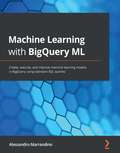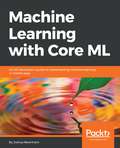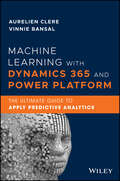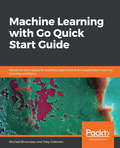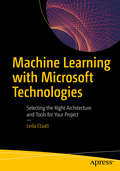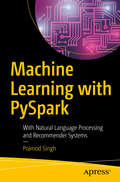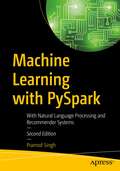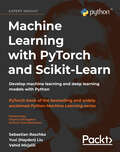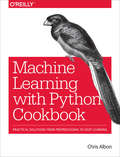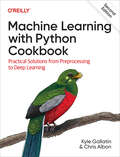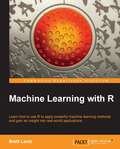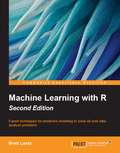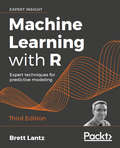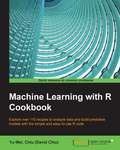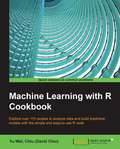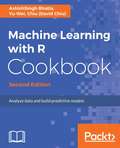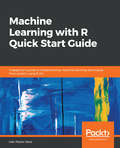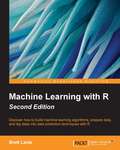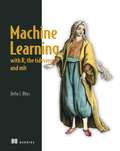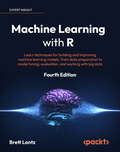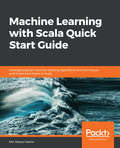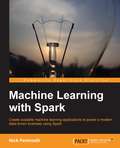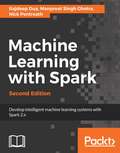- Table View
- List View
Machine Learning with BigQuery ML: Create, execute, and improve machine learning models in BigQuery using standard SQL queries
by Alessandro MarrandinoManage different business scenarios with the right machine learning technique using Google's highly scalable BigQuery MLKey FeaturesGain a clear understanding of AI and machine learning services on GCP, learn when to use these, and find out how to integrate them with BigQuery MLLeverage SQL syntax to train, evaluate, test, and use ML modelsDiscover how BigQuery works and understand the capabilities of BigQuery ML using examplesBook DescriptionBigQuery ML enables you to easily build machine learning (ML) models with SQL without much coding. This book will help you to accelerate the development and deployment of ML models with BigQuery ML. The book starts with a quick overview of Google Cloud and BigQuery architecture. You'll then learn how to configure a Google Cloud project, understand the architectural components and capabilities of BigQuery, and find out how to build ML models with BigQuery ML. The book teaches you how to use ML using SQL on BigQuery. You'll analyze the key phases of a ML model's lifecycle and get to grips with the SQL statements used to train, evaluate, test, and use a model. As you advance, you'll build a series of use cases by applying different ML techniques such as linear regression, binary and multiclass logistic regression, k-means, ARIMA time series, deep neural networks, and XGBoost using practical use cases. Moving on, you'll cover matrix factorization and deep neural networks using BigQuery ML's capabilities. Finally, you'll explore the integration of BigQuery ML with other Google Cloud Platform components such as AI Platform Notebooks and TensorFlow along with discovering best practices and tips and tricks for hyperparameter tuning and performance enhancement. By the end of this BigQuery book, you'll be able to build and evaluate your own ML models with BigQuery ML.What you will learnDiscover how to prepare datasets to build an effective ML modelForecast business KPIs by leveraging various ML models and BigQuery MLBuild and train a recommendation engine to suggest the best products for your customers using BigQuery MLDevelop, train, and share a BigQuery ML model from previous parts with AI Platform NotebooksFind out how to invoke a trained TensorFlow model directly from BigQueryGet to grips with BigQuery ML best practices to maximize your ML performanceWho this book is forThis book is for data scientists, data analysts, data engineers, and anyone looking to get started with Google's BigQuery ML. You'll also find this book useful if you want to accelerate the development of ML models or if you are a business user who wants to apply ML in an easy way using SQL. Basic knowledge of BigQuery and SQL is required.
Machine Learning with Core ML: An iOS developer's guide to implementing machine learning in mobile apps
by Joshua NewnhamLeverage the power of Apple's Core ML to create smart iOS appsKey Features Explore the concepts of machine learning and Apple’s Core ML APIs Use Core ML to understand and transform images and videos Exploit the power of using CNN and RNN in iOS applicationsBook DescriptionCore ML is a popular framework by Apple, with APIs designed to support various machine learning tasks. It allows you to train your machine learning models and then integrate them into your iOS apps.Machine Learning with Core ML is a fun and practical guide that not only demystifies Core ML but also sheds light on machine learning. In this book, you’ll walk through realistic and interesting examples of machine learning in the context of mobile platforms (specifically iOS). You’ll learn to implement Core ML for visual-based applications using the principles of transfer learning and neural networks. Having got to grips with the basics, you’ll discover a series of seven examples, each providing a new use-case that uncovers how machine learning can be applied along with the related concepts. By the end of the book, you will have the skills required to put machine learning to work in their own applications, using the Core ML APIsWhat you will learnUnderstand components of an ML project using algorithms, problems, and dataMaster Core ML by obtaining and importing machine learning model, and generate classesPrepare data for machine learning model and interpret results for optimized solutionsCreate and optimize custom layers for unsupported layers Apply CoreML to image and video data using CNNLearn the qualities of RNN to recognize sketches, and augment drawingUse Core ML transfer learning to execute style transfer on imagesWho this book is forMachine Learning with Core ML is for you if you are an intermediate iOS developer interested in applying machine learning to your mobile apps. This book is also for those who are machine learning developers or deep learning practitioners who want to bring the power of neural networks in their iOS apps. Some exposure to machine learning concepts would be beneficial but not essential, as this book acts as a launchpad into the world of machine learning for developers.
Machine Learning with Dynamics 365 and Power Platform: The Ultimate Guide to Apply Predictive Analytics
by Vinnie Bansal Aurelien ClereApply cutting-edge AI techniques to your Dynamics 365 environment to create new solutions to old business problems In Machine Learning with Dynamics 365 and Power Platform: The Ultimate Guide to Apply Predictive Analytics, an accomplished team of digital and data analytics experts delivers a practical and comprehensive discussion of how to integrate AI Builder with Dataverse and Dynamics 365 to create real-world business solutions. It also walks you through how to build powerful machine learning models using Azure Data Lake, Databricks, Azure Synapse Analytics. The book is filled with clear explanations, visualizations, and working examples that get you up and running in your development of supervised, unsupervised, and reinforcement learning techniques using Microsoft machine learning tools and technologies. These strategies will transform your business verticals, reducing costs and manual processes in finance and operations, retail, telecommunications, and manufacturing industries. The authors demonstrate: What machine learning is all about and how it can be applied to your organization’s Dynamics 365 and Power Platform Projects The creation and management of environments for development, testing, and production of a machine learning project How adopting machine learning techniques will redefine the future of your ERP/CRM system Perfect for Technical Consultants, software developers, and solution architects, Machine Learning with Dynamics 365 and Power Platform is also an indispensable guide for Chief Technology Officers seeking an intuitive resource for how to implement machine learning in modern business applications to solve real-world problems.
Machine Learning with Go Quick Start Guide: Hands-on techniques for building supervised and unsupervised machine learning workflows
by Michael Bironneau Toby ColemanThis quick start guide will bring the readers to a basic level of understanding when it comes to the Machine Learning (ML) development lifecycle, will introduce Go ML libraries and then will exemplify common ML methods such as Classification, Regression, and ClusteringKey FeaturesYour handy guide to building machine learning workflows in Go for real-world scenariosBuild predictive models using the popular supervised and unsupervised machine learning techniquesLearn all about deployment strategies and take your ML application from prototype to production readyBook DescriptionMachine learning is an essential part of today's data-driven world and is extensively used across industries, including financial forecasting, robotics, and web technology. This book will teach you how to efficiently develop machine learning applications in Go.The book starts with an introduction to machine learning and its development process, explaining the types of problems that it aims to solve and the solutions it offers. It then covers setting up a frictionless Go development environment, including running Go interactively with Jupyter notebooks. Finally, common data processing techniques are introduced.The book then teaches the reader about supervised and unsupervised learning techniques through worked examples that include the implementation of evaluation metrics. These worked examples make use of the prominent open-source libraries GoML and Gonum.The book also teaches readers how to load a pre-trained model and use it to make predictions. It then moves on to the operational side of running machine learning applications: deployment, Continuous Integration, and helpful advice for effective logging and monitoring.At the end of the book, readers will learn how to set up a machine learning project for success, formulating realistic success criteria and accurately translating business requirements into technical ones.What you will learnUnderstand the types of problem that machine learning solves, and the various approachesImport, pre-process, and explore data with Go to make it ready for machine learning algorithmsVisualize data with gonum/plot and GophernotesDiagnose common machine learning problems, such as overfitting and underfittingImplement supervised and unsupervised learning algorithms using Go librariesBuild a simple web service around a model and use it to make predictionsWho this book is forThis book is for developers and data scientists with at least beginner-level knowledge of Go, and a vague idea of what types of problem Machine Learning aims to tackle. No advanced knowledge of Go (and no theoretical understanding of the math that underpins Machine Learning) is required.
Machine Learning with Microsoft Technologies: Selecting the Right Architecture and Tools for Your Project
by Leila EtaatiKnow how to do machine learning with Microsoft technologies. This book teaches you to do predictive, descriptive, and prescriptive analyses with Microsoft Power BI, Azure Data Lake, SQL Server, Stream Analytics, Azure Databricks, HD Insight, and more.The ability to analyze massive amounts of real-time data and predict future behavior of an organization is critical to its long-term success. Data science, and more specifically machine learning (ML), is today’s game changer and should be a key building block in every company’s strategy. Managing a machine learning process from business understanding, data acquisition and cleaning, modeling, and deployment in each tool is a valuable skill set. Machine Learning with Microsoft Technologies is a demo-driven book that explains how to do machine learning with Microsoft technologies. You will gain valuable insight into designing the best architecture for development, sharing, and deploying a machine learning solution. This book simplifies the process of choosing the right architecture and tools for doing machine learning based on your specific infrastructure needs and requirements. Detailed content is provided on the main algorithms for supervised and unsupervised machine learning and examples show ML practices using both R and Python languages, the main languages inside Microsoft technologies. What You'll Learn Choose the right Microsoft product for your machine learning solutionCreate and manage Microsoft’s tool environments for development, testing, and production of a machine learning projectImplement and deploy supervised and unsupervised learning in Microsoft products Set up Microsoft Power BI, Azure Data Lake, SQL Server, Stream Analytics, Azure Databricks, and HD Insight to perform machine learning Set up a data science virtual machine and test-drive installed tools, such as Azure ML Workbench, Azure ML Server Developer, Anaconda Python, Jupyter Notebook, Power BI Desktop, Cognitive Services, machine learning and data analytics tools, and more Architect a machine learning solution factoring in all aspects of self service, enterprise, deployment, and sharingWho This Book Is ForData scientists, data analysts, developers, architects, and managers who want to leverage machine learning in their products, organization, and services, and make educated, cost-saving decisions about their ML architecture and tool set.
Machine Learning with PySpark: With Natural Language Processing And Recommender Systems
by Pramod SinghBuild machine learning models, natural language processing applications, and recommender systems with PySpark to solve various business challenges. This book starts with the fundamentals of Spark and its evolution and then covers the entire spectrum of traditional machine learning algorithms along with natural language processing and recommender systems using PySpark. Machine Learning with PySpark shows you how to build supervised machine learning models such as linear regression, logistic regression, decision trees, and random forest. You’ll also see unsupervised machine learning models such as K-means and hierarchical clustering. A major portion of the book focuses on feature engineering to create useful features with PySpark to train the machine learning models. The natural language processing section covers text processing, text mining, and embedding for classification. After reading this book, you will understand how to use PySpark’s machine learning library to build and train various machine learning models. Additionally you’ll become comfortable with related PySpark components, such as data ingestion, data processing, and data analysis, that you can use to develop data-driven intelligent applications.What You Will LearnBuild a spectrum of supervised and unsupervised machine learning algorithmsImplement machine learning algorithms with Spark MLlib librariesDevelop a recommender system with Spark MLlib librariesHandle issues related to feature engineering, class balance, bias and variance, and cross validation for building an optimal fit modelWho This Book Is For Data science and machine learning professionals.
Machine Learning with PySpark: With Natural Language Processing and Recommender Systems
by Pramod SinghMaster the new features in PySpark 3.1 to develop data-driven, intelligent applications. This updated edition covers topics ranging from building scalable machine learning models, to natural language processing, to recommender systems. Machine Learning with PySpark, Second Edition begins with the fundamentals of Apache Spark, including the latest updates to the framework. Next, you will learn the full spectrum of traditional machine learning algorithm implementations, along with natural language processing and recommender systems. You’ll gain familiarity with the critical process of selecting machine learning algorithms, data ingestion, and data processing to solve business problems. You’ll see a demonstration of how to build supervised machine learning models such as linear regression, logistic regression, decision trees, and random forests. You’ll also learn how to automate the steps using Spark pipelines, followed by unsupervised models such as K-means and hierarchical clustering. A section on Natural Language Processing (NLP) covers text processing, text mining, and embeddings for classification. This new edition also introduces Koalas in Spark and how to automate data workflow using Airflow and PySpark’s latest ML library. After completing this book, you will understand how to use PySpark’s machine learning library to build and train various machine learning models, along with related components such as data ingestion, processing and visualization to develop data-driven intelligent applications What you will learn: Build a spectrum of supervised and unsupervised machine learning algorithmsUse PySpark's machine learning library to implement machine learning and recommender systems Leverage the new features in PySpark’s machine learning libraryUnderstand data processing using Koalas in Spark Handle issues around feature engineering, class balance, bias and variance, and cross validation to build optimally fit models Who This Book Is For Data science and machine learning professionals.
Machine Learning with PyTorch and Scikit-Learn: Develop machine learning and deep learning models with Python
by Sebastian Raschka Vahid Mirjalili Yuxi (Hayden) Liu Dmytro DzhulgakovThis book of the bestselling and widely acclaimed Python Machine Learning series is a comprehensive guide to machine and deep learning using PyTorch's simple to code frameworkKey FeaturesLearn applied machine learning with a solid foundation in theoryClear, intuitive explanations take you deep into the theory and practice of Python machine learningFully updated and expanded to cover PyTorch, transformers, XGBoost, graph neural networks, and best practicesBook DescriptionMachine Learning with PyTorch and Scikit-Learn is a comprehensive guide to machine learning and deep learning with PyTorch. It acts as both a step-by-step tutorial and a reference you'll keep coming back to as you build your machine learning systems.Packed with clear explanations, visualizations, and examples, the book covers all the essential machine learning techniques in depth. While some books teach you only to follow instructions, with this machine learning book, we teach the principles allowing you to build models and applications for yourself.Why PyTorch?PyTorch is the Pythonic way to learn machine learning, making it easier to learn and simpler to code with. This book explains the essential parts of PyTorch and how to create models using popular libraries, such as PyTorch Lightning and PyTorch Geometric.You will also learn about generative adversarial networks (GANs) for generating new data and training intelligent agents with reinforcement learning. Finally, this new edition is expanded to cover the latest trends in deep learning, including graph neural networks and large-scale transformers used for natural language processing (NLP).This PyTorch book is your companion to machine learning with Python, whether you're a Python developer new to machine learning or want to deepen your knowledge of the latest developments.What you will learnExplore frameworks, models, and techniques for machines to 'learn' from dataUse scikit-learn for machine learning and PyTorch for deep learningTrain machine learning classifiers on images, text, and moreBuild and train neural networks, transformers, and boosting algorithmsDiscover best practices for evaluating and tuning modelsPredict continuous target outcomes using regression analysisDig deeper into textual and social media data using sentiment analysisWho this book is forIf you know some Python and you want to use machine learning and deep learning, pick up this book. Whether you want to start from scratch or extend your machine learning knowledge, this is an essential resource.Written for developers and data scientists who want to create practical machine learning with Python and PyTorch deep learning code. This Python book is ideal for anyone who wants to teach computers how to learn from data.Working knowledge of the Python programming language, along with a good understanding of calculus and linear algebra is a must.
Machine Learning with PyTorch and Scikit-Learn: Develop machine learning and deep learning models with Python
by Sebastian Raschka Vahid Mirjalili Yuxi (Hayden) LiuThis book of the bestselling and widely acclaimed Python Machine Learning series is a comprehensive guide to machine and deep learning using PyTorch s simple to code framework. Purchase of the print or Kindle book includes a free eBook in PDF format.Key FeaturesLearn applied machine learning with a solid foundation in theoryClear, intuitive explanations take you deep into the theory and practice of Python machine learningFully updated and expanded to cover PyTorch, transformers, XGBoost, graph neural networks, and best practicesBook DescriptionMachine Learning with PyTorch and Scikit-Learn is a comprehensive guide to machine learning and deep learning with PyTorch. It acts as both a step-by-step tutorial and a reference you'll keep coming back to as you build your machine learning systems. Packed with clear explanations, visualizations, and examples, the book covers all the essential machine learning techniques in depth. While some books teach you only to follow instructions, with this machine learning book, we teach the principles allowing you to build models and applications for yourself. Why PyTorch? PyTorch is the Pythonic way to learn machine learning, making it easier to learn and simpler to code with. This book explains the essential parts of PyTorch and how to create models using popular libraries, such as PyTorch Lightning and PyTorch Geometric. You will also learn about generative adversarial networks (GANs) for generating new data and training intelligent agents with reinforcement learning. Finally, this new edition is expanded to cover the latest trends in deep learning, including graph neural networks and large-scale transformers used for natural language processing (NLP). This PyTorch book is your companion to machine learning with Python, whether you're a Python developer new to machine learning or want to deepen your knowledge of the latest developments.What you will learnExplore frameworks, models, and techniques for machines to learn from dataUse scikit-learn for machine learning and PyTorch for deep learningTrain machine learning classifiers on images, text, and moreBuild and train neural networks, transformers, and boosting algorithmsDiscover best practices for evaluating and tuning modelsPredict continuous target outcomes using regression analysisDig deeper into textual and social media data using sentiment analysisWho this book is forIf you have a good grasp of Python basics and want to start learning about machine learning and deep learning, then this is the book for you. This is an essential resource written for developers and data scientists who want to create practical machine learning and deep learning applications using scikit-learn and PyTorch. Before you get started with this book, you’ll need a good understanding of calculus, as well as linear algebra.
Machine Learning with Python Cookbook: Practical Solutions from Preprocessing to Deep Learning
by Chris AlbonThis practical guide provides nearly 200 self-contained recipes to help you solve machine learning challenges you may encounter in your daily work. If you’re comfortable with Python and its libraries, including pandas and scikit-learn, you’ll be able to address specific problems such as loading data, handling text or numerical data, model selection, and dimensionality reduction and many other topics.Each recipe includes code that you can copy and paste into a toy dataset to ensure that it actually works. From there, you can insert, combine, or adapt the code to help construct your application. Recipes also include a discussion that explains the solution and provides meaningful context. This cookbook takes you beyond theory and concepts by providing the nuts and bolts you need to construct working machine learning applications.You’ll find recipes for:Vectors, matrices, and arraysHandling numerical and categorical data, text, images, and dates and timesDimensionality reduction using feature extraction or feature selectionModel evaluation and selectionLinear and logical regression, trees and forests, and k-nearest neighborsSupport vector machines (SVM), naïve Bayes, clustering, and neural networksSaving and loading trained models
Machine Learning with Python Cookbook: Practical Solutions from Preprocessing to Deep Learning
by Chris Albon Kyle GallatinThis practical guide provides more than 200 self-contained recipes to help you solve machine learning challenges you may encounter in your work. If you're comfortable with Python and its libraries, including pandas and scikit-learn, you'll be able to address specific problems, from loading data to training models and leveraging neural networks.Each recipe in this updated edition includes code that you can copy, paste, and run with a toy dataset to ensure that it works. From there, you can adapt these recipes according to your use case or application. Recipes include a discussion that explains the solution and provides meaningful context.Go beyond theory and concepts by learning the nuts and bolts you need to construct working machine learning applications. You'll find recipes for:Vectors, matrices, and arraysWorking with data from CSV, JSON, SQL, databases, cloud storage, and other sourcesHandling numerical and categorical data, text, images, and dates and timesDimensionality reduction using feature extraction or feature selectionModel evaluation and selectionLinear and logical regression, trees and forests, and k-nearest neighborsSupporting vector machines (SVM), naäve Bayes, clustering, and tree-based modelsSaving, loading, and serving trained models from multiple frameworks
Machine Learning with R
by Brett LantzWritten as a tutorial to explore and understand the power of R for machine learning. This practical guide that covers all of the need to know topics in a very systematic way. For each machine learning approach, each step in the process is detailed, from preparing the data for analysis to evaluating the results. These steps will build the knowledge you need to apply them to your own data science tasks.Intended for those who want to learn how to use R's machine learning capabilities and gain insight from your data. Perhaps you already know a bit about machine learning, but have never used R; or perhaps you know a little R but are new to machine learning. In either case, this book will get you up and running quickly. It would be helpful to have a bit of familiarity with basic programming concepts, but no prior experience is required.
Machine Learning with R - Second Edition
by Brett LantzPerhaps you already know a bit about machine learning but have never used R, or perhaps you know a little R but are new to machine learning. In either case, this book will get you up and running quickly.<P><P> It would be helpful to have a bit of familiarity with basic programming concepts, but no prior experience is required.
Machine Learning with R - Third Edition
by Brett LantzData scientists, students, and other practitioners who want a clear, accessible guide to machine learning with R.
Machine Learning with R Cookbook
by Chiu Yu-Wei<P><P>Key Features <P><P>Apply R to simplify predictive modeling with short and simple code <P><P>Use machine learning to solve problems ranging from small to big data <P><P>Build a training and testing dataset from the churn dataset, applying different classification methods <P><P>Book Description <P><P>The R language is a powerful open source functional programming language. At its core, R is a statistical programming language that provides impressive tools to analyze data and create high-level graphics. <P><P>This book covers the basics of R by setting up a user-friendly programming environment and performing data ETL in R. Data exploration examples are provided that demonstrate how powerful data visualization and machine learning is in discovering hidden relationships. You will then dive into important machine learning topics, including data classification, regression, clustering, association rule mining, and dimension reduction. <P><P>What you will learn <P><P>Create and inspect the transaction dataset, performing association analysis with the Apriori algorithm <P><P>Visualize patterns and associations using a range of graphs and find frequent itemsets using the Eclat algorithm <P><P>Compare differences between each regression method to discover how they solve problems <P><P>Predict possible churn users with the classification approach <P><P>Implement the clustering method to segment customer data <P><P>Compress images with the dimension reduction method <P><P>Incorporate R and Hadoop to solve machine learning problems on Big Data
Machine Learning with R Cookbook
by Yu-Wei ChiuIf you want to learn how to use R for machine learning and gain insights from your data, then this book is ideal for you. Regardless of your level of experience, this book covers the basics of applying R to machine learning through to advanced techniques. While it is helpful if you are familiar with basic programming or machine learning concepts, you do not require prior experience to benefit from this book.
Machine Learning with R Cookbook, Second Edition
by AshishSingh Bhatia<P><P>Explore over 110 recipes to analyze data and build predictive models with simple and easy-to-use R code <P><P>About This Book <P><P>Apply R to simplify predictive modeling with short and simple code <P><P>Use machine learning to solve problems ranging from small to big data <P><P>Build a training and testing dataset, applying different classification methods. <P><P>Who This Book Is For <P><P>This book is for data science professionals, data analysts, or people who have used R for data analysis and machine learning who now wish to become the go-to person for machine learning with R. Those who wish to improve the efficiency of their machine learning models and need to work with different kinds of data set will find this book very insightful. <P><P>What You Will Learn <P><P>Create and inspect transaction datasets and perform association analysis with the Apriori algorithm <P><P>Visualize patterns and associations using a range of graphs and find frequent item-sets using the Eclat algorithm <P><P>Compare differences between each regression method to discover how they solve problems <P><P>Detect and impute missing values in air quality data <P><P>Predict possible churn users with the classification approach <P><P>Plot the autocorrelation function with time series analysis <P><P>Use the Cox proportional hazards model for survival analysis <P><P>Implement the clustering method to segment customer data <P><P>Compress images with the dimension reduction method <P><P>Incorporate R and Hadoop to solve machine learning problems on big data <P><P>In Detail <P><P>Big data has become a popular buzzword across many industries. An increasing number of people have been exposed to the term and are looking at how to leverage big data in their own businesses, to improve sales and profitability. However, collecting, aggregating, and visualizing data is just one part of the equation. Being able to extract useful information from data is another task, and a much more challenging one. Machine Learning with R Cookbook, Second Edition uses a practical approach to teach you how to perform machine learning with R. Each chapter is divided into several simple recipes. Through the step-by-step instructions provided in each recipe, you will be able to construct a predictive model by using a variety of machine learning packages. In this book, you will first learn to set up the R environment and use simple R commands to explore data. The next topic covers how to perform statistical analysis with machine learning analysis and assess created models, covered in detail later on in the book. You'll also learn how to integrate R and Hadoop to create a big data analysis platform. The detailed illustrations provide all the information required to start applying machine learning to individual projects. With Machine Learning with R Cookbook, machine learning has never been easier.
Machine Learning with R Quick Start Guide: A beginner's guide to implementing machine learning techniques from scratch using R 3.5
by Ivan Pastor SanzLearn how to use R to apply powerful machine learning methods and gain insight into real-world applications using clustering, logistic regressions, random forests, support vector machine, and more. Key Features Use R 3.5 to implement real-world examples in machine learning Implement key machine learning algorithms to understand the working mechanism of smart models Create end-to-end machine learning pipelines using modern libraries from the R ecosystem Book Description Machine Learning with R Quick Start Guide takes you on a data-driven journey that starts with the very basics of R and machine learning. It gradually builds upon core concepts so you can handle the varied complexities of data and understand each stage of the machine learning pipeline. From data collection to implementing Natural Language Processing (NLP), this book covers it all. You will implement key machine learning algorithms to understand how they are used to build smart models. You will cover tasks such as clustering, logistic regressions, random forests, support vector machines, and more. Furthermore, you will also look at more advanced aspects such as training neural networks and topic modeling. By the end of the book, you will be able to apply the concepts of machine learning, deal with data-related problems, and solve them using the powerful yet simple language that is R. What you will learn Introduce yourself to the basics of machine learning with R 3.5 Get to grips with R techniques for cleaning and preparing your data for analysis and visualize your results Learn to build predictive models with the help of various machine learning techniques Use R to visualize data spread across multiple dimensions and extract useful features Use interactive data analysis with R to get insights into data Implement supervised and unsupervised learning, and NLP using R libraries Who this book is for This book is for graduate students, aspiring data scientists, and data analysts who wish to enter the field of machine learning and are looking to implement machine learning techniques and methodologies from scratch using R 3.5. A working knowledge of the R programming language is expected.
Machine Learning with R Second Edition
by Brett Lantz<P><P>Build machine learning algorithms, prepare data, and dig deep into data prediction techniques with R <P><P>Key Features <P><P>Harness the power of R for statistical computing and data science <P><P>Explore, forecast, and classify data with R <P><P>Use R to apply common machine learning algorithms to real-world scenarios <P><P>Book Description <P><P>Machine learning, at its core, is concerned with transforming data into actionable knowledge. This makes machine learning well suited to the present-day era of big data. Given the growing prominence of R's cross-platform, zero-cost statistical programming environment, there has never been a better time to start applying machine learning to your data. Machine learning with R offers a powerful set of methods to quickly and easily gain insight from your data to both, veterans and beginners in data analytics. <P><P>Want to turn your data into actionable knowledge, predict outcomes that make real impact, and have constantly developing insights? R gives you access to all the power you need to master exceptional machine learning techniques. <P><P>The second edition of Machine Learning with R provides you with an introduction to the essential skills required in data science. Without shying away from technical theory, it is written to provide focused and practical knowledge to get you building algorithms and crunching your data, with minimal previous experience. <P><P>With this book, you'll discover all the analytical tools you need to gain insights from complex data and learn to to choose the correct algorithm for your specific needs. Through full engagement with the sort of real-world problems data-wranglers face, you'll learn to apply machine learning methods to deal with common tasks, including classification, prediction, forecasting, market analysis, and clustering. Transform the way you think about data; discover machine learning with R. <P><P>What you will learn <P><P>Harness the power of R to build common machine learning algorithms with real-world data science applications <P><P>Get to grips with techniques in R to clean and prepare your data for analysis and visualize your results <P><P>Discover the different types of machine learning models and learn what is best to meet your data needs and solve data analysis problems <P><P>Classify your data with Bayesian and nearest neighbour methods <P><P>Predict values using R to build decision trees, rules, and support vector machines <P><P>Forecast numeric values with linear regression and model your data with neural networks <P><P>Evaluate and improve the performance of machine learning models <P><P>Learn specialized machine learning techniques for text mining, social network data, and big data
Machine Learning with R, the tidyverse, and mlr
by Hefin RhysSummary Machine learning (ML) is a collection of programming techniques for discovering relationships in data. With ML algorithms, you can cluster and classify data for tasks like making recommendations or fraud detection and make predictions for sales trends, risk analysis, and other forecasts. Once the domain of academic data scientists, machine learning has become a mainstream business process, and tools like the easy-to-learn R programming language put high-quality data analysis in the hands of any programmer. Machine Learning with R, the tidyverse, and mlr teaches you widely used ML techniques and how to apply them to your own datasets using the R programming language and its powerful ecosystem of tools. This book will get you started! Purchase of the print book includes a free eBook in PDF, Kindle, and ePub formats from Manning Publications. About the book Machine Learning with R, the tidyverse, and mlr gets you started in machine learning using R Studio and the awesome mlr machine learning package. This practical guide simplifies theory and avoids needlessly complicated statistics or math. All core ML techniques are clearly explained through graphics and easy-to-grasp examples. In each engaging chapter, you&’ll put a new algorithm into action to solve a quirky predictive analysis problem, including Titanic survival odds, spam email filtering, and poisoned wine investigation. What's inside Using the tidyverse packages to process and plot your data Techniques for supervised and unsupervised learning Classification, regression, dimension reduction, and clustering algorithms Statistics primer to fill gaps in your knowledge About the reader For newcomers to machine learning with basic skills in R. About the author Hefin I. Rhys is a senior laboratory research scientist at the Francis Crick Institute. He runs his own YouTube channel of screencast tutorials for R and RStudio. Table of contents: PART 1 - INTRODUCTION 1.Introduction to machine learning 2. Tidying, manipulating, and plotting data with the tidyverse PART 2 - CLASSIFICATION 3. Classifying based on similarities with k-nearest neighbors 4. Classifying based on odds with logistic regression 5. Classifying by maximizing separation with discriminant analysis 6. Classifying with naive Bayes and support vector machines 7. Classifying with decision trees 8. Improving decision trees with random forests and boosting PART 3 - REGRESSION 9. Linear regression 10. Nonlinear regression with generalized additive models 11. Preventing overfitting with ridge regression, LASSO, and elastic net 12. Regression with kNN, random forest, and XGBoost PART 4 - DIMENSION REDUCTION 13. Maximizing variance with principal component analysis 14. Maximizing similarity with t-SNE and UMAP 15. Self-organizing maps and locally linear embedding PART 5 - CLUSTERING 16. Clustering by finding centers with k-means 17. Hierarchical clustering 18. Clustering based on density: DBSCAN and OPTICS 19. Clustering based on distributions with mixture modeling 20. Final notes and further reading
Machine Learning with R: Expert techniques for predictive modeling, 3rd Edition
by Brett LantzSolve real-world data problems with R and machine learningKey FeaturesThird edition of the bestselling, widely acclaimed R machine learning book, updated and improved for R 3.6 and beyondHarness the power of R to build flexible, effective, and transparent machine learning modelsLearn quickly with a clear, hands-on guide by experienced machine learning teacher and practitioner, Brett LantzBook DescriptionMachine learning, at its core, is concerned with transforming data into actionable knowledge. R offers a powerful set of machine learning methods to quickly and easily gain insight from your data.Machine Learning with R, Third Edition provides a hands-on, readable guide to applying machine learning to real-world problems. Whether you are an experienced R user or new to the language, Brett Lantz teaches you everything you need to uncover key insights, make new predictions, and visualize your findings.This new 3rd edition updates the classic R data science book to R 3.6 with newer and better libraries, advice on ethical and bias issues in machine learning, and an introduction to deep learning. Find powerful new insights in your data; discover machine learning with R.What you will learnDiscover the origins of machine learning and how exactly a computer learns by examplePrepare your data for machine learning work with the R programming languageClassify important outcomes using nearest neighbor and Bayesian methodsPredict future events using decision trees, rules, and support vector machinesForecast numeric data and estimate financial values using regression methodsModel complex processes with artificial neural networks — the basis of deep learningAvoid bias in machine learning modelsEvaluate your models and improve their performanceConnect R to SQL databases and emerging big data technologies such as Spark, H2O, and TensorFlowWho this book is forData scientists, students, and other practitioners who want a clear, accessible guide to machine learning with R.
Machine Learning with R: Learn techniques for building and improving machine learning models, from data preparation to model tuning, evaluation, and working with big data, 4th Edition
by Brett LantzLearn how to solve real-world data problems using machine learning and RPurchase of the print or Kindle book includes a free eBook in PDF format.Key FeaturesThe 10th Anniversary Edition of the bestselling R machine learning book, updated with 50% new content for R 4.0.0 and beyondHarness the power of R to build flexible, effective, and transparent machine learning modelsLearn quickly with this clear, hands-on guide by machine learning expert Brett LantzBook DescriptionMachine learning, at its core, is concerned with transforming data into actionable knowledge. R offers a powerful set of machine learning methods to quickly and easily gain insight from your data. Machine Learning with R, Fourth Edition, provides a hands-on, accessible, and readable guide to applying machine learning to real-world problems. Whether you are an experienced R user or new to the language, Brett Lantz teaches you everything you need to know for data pre-processing, uncovering key insights, making new predictions, and visualizing your findings. This 10th Anniversary Edition features several new chapters that reflect the progress of machine learning in the last few years and help you build your data science skills and tackle more challenging problems, including making successful machine learning models and advanced data preparation, building better learners, and making use of big data.You'll also find this classic R data science book updated to R 4.0.0 with newer and better libraries, advice on ethical and bias issues in machine learning, and an introduction to deep learning. Whether you're looking to take your first steps with R for machine learning or making sure your skills and knowledge are up to date, this is an unmissable read that will help you find powerful new insights in your data.What you will learnLearn the end-to-end process of machine learning from raw data to implementationClassify important outcomes using nearest neighbor and Bayesian methodsPredict future events using decision trees, rules, and support vector machinesForecast numeric data and estimate financial values using regression methodsModel complex processes with artificial neural networksPrepare, transform, and clean data using the tidyverseEvaluate your models and improve their performanceConnect R to SQL databases and emerging big data technologies such as Spark, Hadoop, H2O, and TensorFlowWho this book is forThis book is designed to help data scientists, actuaries, data analysts, financial analysts, social scientists, business and machine learning students, and any other practitioners who want a clear, accessible guide to machine learning with R. No R experience is required, although prior exposure to statistics and programming is helpful.
Machine Learning with Scala Quick Start Guide: Leverage popular machine learning algorithms and techniques and implement them in Scala
by Md. Rezaul KarimSupervised and unsupervised machine learning made easy in Scala with this quick-start guide.Key FeaturesConstruct and deploy machine learning systems that learn from your data and give accurate predictionsUnleash the power of Spark ML along with popular machine learning algorithms to solve complex tasks in Scala.Solve hands-on problems by combining popular neural network architectures such as LSTM and CNN using Scala with DeepLearning4j libraryBook DescriptionScala is a highly scalable integration of object-oriented nature and functional programming concepts that make it easy to build scalable and complex big data applications. This book is a handy guide for machine learning developers and data scientists who want to develop and train effective machine learning models in Scala.The book starts with an introduction to machine learning, while covering deep learning and machine learning basics. It then explains how to use Scala-based ML libraries to solve classification and regression problems using linear regression, generalized linear regression, logistic regression, support vector machine, and Naïve Bayes algorithms.It also covers tree-based ensemble techniques for solving both classification and regression problems. Moving ahead, it covers unsupervised learning techniques, such as dimensionality reduction, clustering, and recommender systems. Finally, it provides a brief overview of deep learning using a real-life example in Scala.What you will learnGet acquainted with JVM-based machine learning libraries for Scala such as Spark ML and Deeplearning4jLearn RDDs, DataFrame, and Spark SQL for analyzing structured and unstructured dataUnderstand supervised and unsupervised learning techniques with best practices and pitfallsLearn classification and regression analysis with linear regression, logistic regression, Naïve Bayes, support vector machine, and tree-based ensemble techniques Learn effective ways of clustering analysis with dimensionality reduction techniquesLearn recommender systems with collaborative filtering approachDelve into deep learning and neural network architecturesWho this book is forThis book is for machine learning developers looking to train machine learning models in Scala without spending too much time and effort. Some fundamental knowledge of Scala programming and some basics of statistics and linear algebra is all you need to get started with this book.
Machine Learning with Spark
by Nick PentreathIf you are a Scala, Java, or Python developer with an interest in machine learning and data analysis and are eager to learn how to apply common machine learning techniques at scale using the Spark framework, this is the book for you. While it may be useful to have a basic understanding of Spark, no previous experience is required.
Machine Learning with Spark - Second Edition
by Rajdeep DuaIf you have a basic knowledge of machine learning and want to implement various machine-learning concepts in the context of Spark ML, this book is for you. You should be well versed with the Scala and Python languages.
